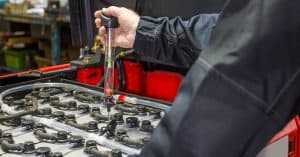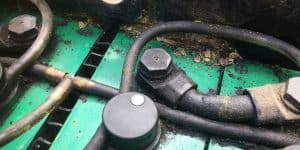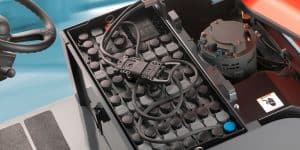Most warehousing operations will use one of two main battery types to power their forklifts: lithium-ion batteries and lead acid batteries.
A third type exists, nickel cadmium batteries, but these are costly and can be difficult to handle. They’re ultra-reliable and are right for some businesses, but for most, lead acid or lithium-ion will prove more economical.
Of these two options, which is the most affordable forklift battery? Broadly speaking, lead acid batteries are cheaper to buy up front but may well end up costing you more over five years, while lithium-ion has a greater purchase price but is potentially more cost-effective in the long-run. As for which option you should choose, the right answer comes down to your operational requirements.
Read on to find out how each type of battery is used, their different benefits, and what you need to think about before you decide which option is right for you.
Lead acid batteries explained
Lead acid batteries are ‘traditional’ batteries, invented all the way back in 1859. They’re tried-and-tested in the material handling industry and have been used for decades in forklifts and elsewhere. They are the same technology most of us have in our cars.
A lead acid battery that you buy now is little different to one that you could have bought 50 or even 100 years ago. The technology has been refined over time, but the fundamentals haven’t changed.
What are lithium-ion batteries?
Lithium-ion batteries are a much newer technology, invented in 1991. Mobile phone batteries are lithium-ion batteries. They can be recharged much faster than other commercial battery types and are perhaps best known for their environmental benefits.
While they are more expensive than lead acid batteries up front, they are cheaper to maintain and use. Even though the initial investment is higher, some businesses could save money using lithium-ion batteries as a result of the lower operational and maintenance costs.
Lead acid batteries in the warehouse
Where a business is operating multiple shifts, a fully-charged lead acid battery will be installed onto each truck at the start of the shift and will last for that shift. At the end of the shift, each battery will be removed for charging and replaced by another fully-charged battery. This means that each battery has enough time to be charged again before the next shift begins.
Given their lower cost to purchase, this means that lead acid batteries can be a more economical choice for businesses with a single shift operation. Batteries will work throughout the shift without a hitch and, when operations finish, can be easily charged, ready for the next day.
For multi-shift operations, using a lead acid battery will be less economical. You will need to purchase and maintain more batteries than forklifts to ensure that there is always a fresh battery available to be loaded while the previous battery is charging.
If you are running three eight-hour shifts, then you’ll need three batteries for each truck you’re operating. You’ll also need plenty of space to charge them and people available to put them on charge. Lead acid batteries are bulky and heavy, so taking the batteries out of each forklift and charging them adds an extra job to each shift. Because they contain acid, lead acid batteries need to be handled and stored with care while charging.
Lithium-ion batteries in the warehouse
Lithium-ion batteries are designed to stay in the forklift, and do not need to be removed for recharging. They can also be charged throughout the day, so when an operator stops for a break, they can plug their truck in to charge and come back to a recharged battery capable of running for the remainder of the shift. A lithium-ion battery can gain a full charge in one or two hours.
They work exactly like a mobile phone battery. If your phone battery drops to 20%, you can charge it for 30 minutes and, while it won’t be fully charged, it will still be usable.
Lithium-ion batteries usually have a much smaller capacity than the equivalent lead acid battery. A lead acid battery might have a capacity of 600 ampere hours, and a lithium ion battery only 200.
However, this isn’t a problem because a lithium-ion battery can be quickly recharged throughout each shift. Warehouse operatives need to remember to charge the battery every time they stop work. There is a risk that, if they forget, the battery will run out, taking the truck out of action.
If you use lithium-ion batteries, you’ll need to make sure you have space in the warehouse for trucks to recharge forklifts throughout the day. This usually takes the form of designated charging points. Staggered break times can help manage this process, so that not all staff are trying to charge their truck at the same time. Lithium-ion batteries are therefore the more economical option for warehouses running 24/7 operations or multiple shifts back to back, because fewer batteries are required compared to lead acid types and trucks can run indefinitely around their operators’ breaks, increasing productivity and boosting efficiencies.
How long does a forklift battery last?
Lithium-ion batteries usually last for 2,000 to 3,000 charge cycles, while lead acid batteries for 1,000 to 1,500 cycles.
That sounds like a clear win for lithium-ion batteries, but if you have multiple shifts, with lithium-ion batteries being charged regularly throughout each day, then the life of each battery will be shorter than if you were using lead acid batteries that are removed and swapped at the start of each shift.
Lithium-ion batteries are lower-maintenance than lead acid batteries, which can mean they last longer before they reach their end of life. Lead acid batteries need to be kept topped up with water to protect the lead plates inside them, and they will become damaged if they are allowed to get too hot or too cold.
Which is the most economical for your operations?
The cost of each type of battery needs to be worked out around your operations’ needs, budget and circumstances. If you have a single-shift operation, a low forklift count and space to charge batteries, lead acid might be more economical. If you have multiple shifts, a larger fleet and little space or time to deal with removing and recharging batteries, lithium-ion might work out cheaper.



